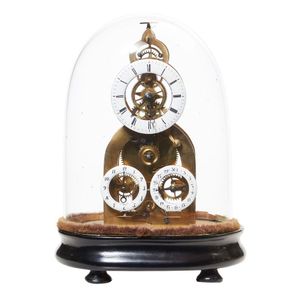French Skeleton Clock with Alarm and Date Dial
You must be a subscriber, and be logged in to view price and dealer details.
Subscribe Now to view actual auction price for this item
When you subscribe, you have the option of setting the currency in which to display prices to $Au, $US, $NZ or Stg.
- Pendulum - The pendulum was discovered around 1602 by Galileo Galilei, and was adopted for time keeping by the Dutch mathematician and natural philosopher, Christiaan Huygens, who excelled in astronomy, physics, and horology.
The pendulum comprises a metal rod usually of brass or steel with a metal disk, known as a bob, at the end. The movement of the pendulum is driven by weights or a spring, and as a pendulum swings in a regular arc, it was found accuracy could be controlled to within a few seconds a week.
Timekeeping can be adjusted by changing the height of the bob on the rod, making the pendulum either swing slower or faster.
The disadvantage of the pendulum was that changes in temperature also changed the length of the pendulum, interfering with the accuracy of the clock, and so in the 18th century two types of mercurial pendulums were invented which countered the movement in the steel rod.
The pendulum was the world's most accurate timekeeping technology until the invention of the quartz clock, regulated by a quartz crystal, in 1927. - Date Aperture - A date aperture is a cut out section in the face of a watch or clock, displaying the day of the month.
- Circa - A Latin term meaning 'about', often used in the antique trade to give an approximate date for the piece, usually considered to be five years on either side of the circa year. Thus, circa 1900 means the piece was made about 1900, probably between 1895 and 1905. The expression is sometimes abbreviated to c.1900.
This item has been included into following indexes:
-
clocks, type
- skeleton 78
- under glass dome 198
- meat covers / food covers / dish covers - pewter 1,629
Visually similar items

A black slate and enamel moonphase clock, French, circa 1900, with two train movement and visible escapement, 44 cm high

'A fine Louis XVI ormolu mantel clock, last quarter 18th century. The circular white enamel dial with black Roman and Arabic numerals and inscribed Balthazar a Paris, the two-train movement contained within a drum-shaped case supported by a boat laden with

Chrome Swiss desk clock, with musical movement, 9 cm high approx.

A French Gilted mantel clock, the enamel dial flanked by the Labour allegory, two train movement, the mechanism marked 'Japy Freres and Cie, Medaille d'Honneur', the clock on a composite base, under wood. (key and pendulum). Height 30 cm
